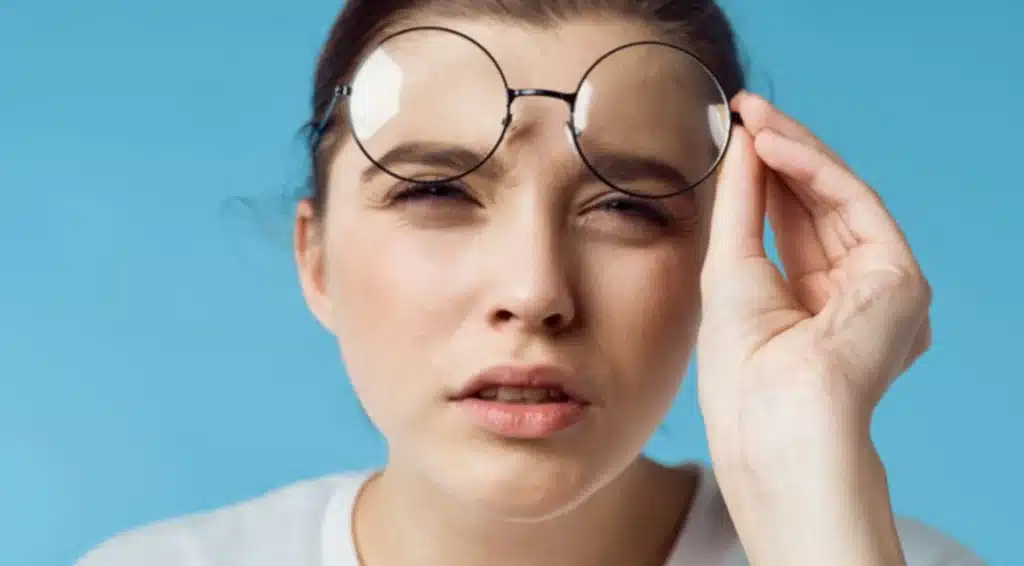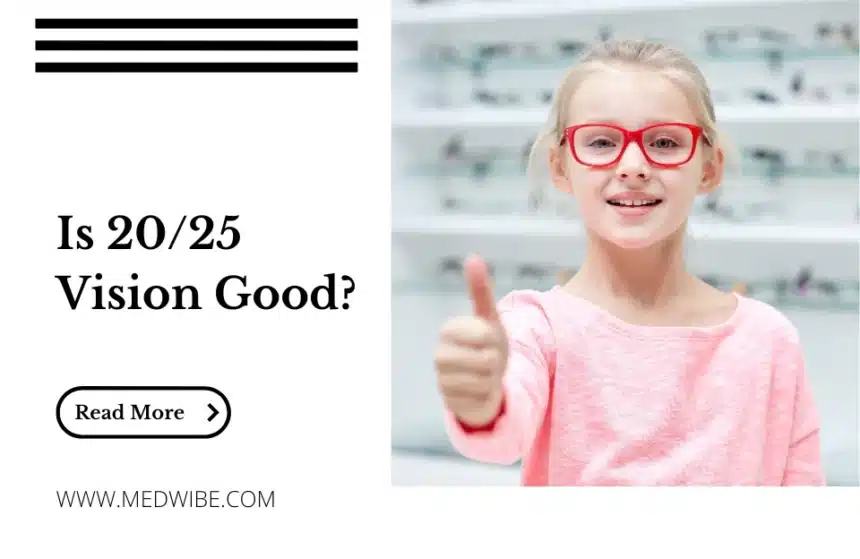Key Points
- 20/25 vision means what a person with normal vision sees at 25 feet, you see clearly at 20 feet.
- Common causes include refractive errors (like myopia, hyperopia, and astigmatism), age-related changes, and eye conditions.
- It may cause slight difficulty in reading small print and challenges in low light conditions and could lead to quicker eye strain, especially from prolonged screen use.
- 20/25 Vision can be corrected with eyeglasses, contact lenses, or refractive surgery. Regular eye exams are crucial for monitoring and maintaining eye health.
20/25 Vision Meaning
When we talk about 20/25 vision, we’re referring to a standard used to measure visual acuity. Essentially, if you have 20 25 vision, it means you can see at 25 feet what a person with “normal” vision can see at 20 feet. It’s a comparison to the benchmark of 20/20 vision, which is considered sharp or optimal vision.
Is 20/25 Vision Good?
Yes, 20/25 vision is generally considered good. Many people with this visual acuity level don’t have significant difficulties in their daily activities and may not even need corrective lenses. However, it’s slightly below the ideal 20/20 standard, indicating there’s room for improvement or at least a reason to pay attention to eye health.
20/25 Vision Causes

20 25 vision, while considered to be near-normal, indicates that your eyesight is slightly below the optimal 20/20 vision standard. Understanding the causes behind 20 25 vision can help you take proactive steps towards maintaining or improving your eye health. Here are some of the most common causes:
Refractive Errors
Refractive errors are the most frequent cause of 20/25 vision. They occur when the shape of your eye doesn’t bend light correctly, resulting in a blurred image. The main types of refractive errors include:
- Myopia (Nearsightedness): Objects nearby are clear, while distant objects are blurry.
- Hyperopia (Farsightedness): Distant objects are easier to see than close ones, but both may be blurry if the hyperopia is significant.
- Astigmatism: This results from an irregular curvature of the cornea or lens, leading to blurred vision at any distance.
Age-Related Changes
As we age, our eyes undergo natural changes that can affect vision clarity, including the development of presbyopia (difficulty focusing on close objects) and changes in the eye’s lens, affecting its ability to focus light accurately.
Eye Conditions and Diseases
Certain eye conditions and diseases can contribute to 20/25 vision, including:
- Cataracts: A clouding of the eye’s lens that affects vision.
- Macular Degeneration: Affects the part of the retina responsible for sharp, central vision.
- Glaucoma: A group of eye conditions that damage the optic nerve, potentially affecting vision clarity.
Lifestyle and Environmental Factors
Extended screen time, poor lighting conditions, and not using proper eye protection can strain the eyes, potentially leading to temporary or permanent changes in vision.
Can you achieve 20/10 Vision? Find out now.
Effects of 20/25 Vision

Here are some potential effects of having 20/25 vision:
Slight Difficulty in Reading Small Print
Individuals with 20/25 vision might experience slight difficulty reading very small print or seeing fine details from a distance where a person with perfect 20/20 vision would not. This could be noticeable in activities like reading small text on a sign or in a book without straining.
Challenges in Low Light Conditions
Vision clarity can decrease in low light conditions, and this effect may be slightly more pronounced for someone with 20 25 vision compared to someone with 20/20 vision. Difficulty in seeing clearly in dimly lit areas or at night can be a concern, particularly for activities like driving.
Eye Strain from Screen Use
People with 20 25 vision might experience eye strain or fatigue quicker than those with perfect vision, especially during prolonged periods of screen use. Computers, smartphones, and tablets require the eyes to focus and refocus constantly, which can be tiring if your vision is not optimal.
Potential for Increased Myopia Risk
If 20/25 vision is due to myopia (nearsightedness), there might be a risk of the condition worsening over time, especially in children and young adults, whose eyes are still changing. Regular eye examinations are important to monitor and correct vision changes.
Find out risks involved in getting Eyelid tattoos in this guide.
How to Fix 20/25 Vision?

Improving 20/25 vision often involves simple corrective measures, such as:
Regular Eye Exams
Regular check-ups are crucial for keeping an eye on any changes in your vision and adjusting your prescription as necessary. These exams can also help in the early detection of eye conditions that might affect your vision, ensuring timely treatment.
Protective Measures
Protect your eyes from harmful UV rays which can deteriorate vision over time. When engaging in sports or working with materials that could harm your eyes, always wear appropriate protective eyewear.
Limit Screen Time
Reduce the risk of digital eye strain by limiting the time spent in front of computer screens and smartphones. Follow the 20-20-20 rule: every 20 minutes, look at something 20 feet away for at least 20 seconds.
Laser Eye Surgery
For some individuals, procedures like LASIK or PRK (photorefractive keratectomy) could be viable options to correct vision to 20/20 or better. These surgeries reshape the cornea, correcting the refractive errors that cause vision issues.
Orthokeratology (Ortho-K)
Ortho-K involves wearing specially designed rigid gas-permeable contact lenses overnight. These lenses temporarily reshape the cornea, allowing for clearer vision during the day without the need for glasses or contacts.
20/20 Vision Vs 20/25 Vision
The main difference is the level of sharpness and detail a person can see. With 20/20 vision being the standard for clarity and acuity, 20/25 is just a step below but still within the range of what’s considered normal vision.
Find out detailed guide about 20/20 Vision and its benefits on healthcare blogs in USA.
20/25 Vision Prescription
If your vision is measured at 20/25, you might not always need a prescription. However, if you experience strain or discomfort, an optometrist can prescribe lenses that correct your vision to 20/20.
20/25 Vision with Astigmatism
Astigmatism can accompany 20/25 vision, leading to slightly blurred or distorted vision. Corrective lenses designed to address astigmatism can significantly improve visual clarity.
Is 20/25 Vision Farsighted or Nearsighted?
20 25 vision can result from either condition, though it’s often associated with mild nearsightedness, where distant objects are a bit blurrier than close ones.
Is it Okay to Drive With 20/25 Vision?
Yes, it’s generally safe to drive with 20 25 vision. In many jurisdictions, the legal requirement for driving is slightly below 20/25. Nonetheless, if you feel uncomfortable or unsafe, consider corrective lenses.
Conclusion
While 20/25 vision is slightly below the ideal, it’s still considered good and doesn’t usually hinder daily activities. Regular eye check-ups, protective measures, and corrective solutions when necessary can help maintain or improve your vision. Remember, taking care of your eyes is an integral part of overall health, so give them the attention they deserve.
FAQs
Is 20/25 vision normal?
Yes, 20/25 vision is considered slightly below perfect but is generally seen as normal and does not typically require correction for daily activities.
Can 20 25 vision cause headaches?
20 25 vision can cause headaches if it leads to eye strain from trying to focus or squinting, especially during tasks requiring sharp visual acuity.
Can 20/25 vision be corrected?
Yes, 20 25 vision can often be corrected to 20/20 with prescription eyeglasses, contact lenses, or through refractive surgeries like LASIK.
Is 20 25 vision better than 20/20?
No, 20 25 vision is not better than 20/20. 20/20 vision is considered the standard for normal, clear vision, whereas 20 25 indicates slightly reduced visual acuity.
Does 20/25 Vision Need Glasses?
Not necessarily. The need for glasses depends on your personal experience of vision, potential eye strain, and if you have any additional vision issues like astigmatism.




